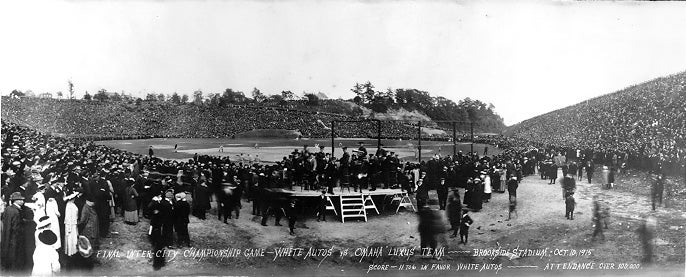BROOKSIDE RESERVATION, located in southwestern Cleveland is one of the city’s oldest municipal parks. Located in wooded Big Creek Valley, the site features scenic bluffs overlooking a large east-west-oriented vale. The land was acquired in 1894 by the Cleveland Park Board and initially named Brooklyn Park. Deemed ideal for recreational activities, including picnicking, playgrounds and outdoor sports, the Board nearly doubled the park’s size within 3 years: from its initial 81 acres to more than 160 in 1897, when it was renamed Brookside Park
In his diaries, chief parks engineer WILLIAM STINCHCOMB (1878-1959) recorded extensive improvements to the Brookside property beginning in the early 20th century: cinder-paved drives and paths; improved athletic fields; extensive grading, planting, and lawn maintenance; and the acquisition of new land for a lake and shelter house. In 1915 more than 100,000 Clevelanders watched White Auto and Omaha 'Luxus' play a baseball game at Brookside Park Stadium. This is believed to be the largest crowd ever to attend a baseball game in Cleveland.
Between 1905 and 1916, the Cleveland Zoological Park (now CLEVELAND METROPARKS ZOO) moved from its original site at WADE PARK to the eastern end of Brookside by the foot of Fulton Hill. Additional landscaping work was completed in the 1930s and 1940s, but the construction of 1-71 during the 1960s claimed forested areas along the Park’s northwestern border.
CLEVELAND METROPARKS took over management from the City of Cleveland in 1993, at which time Brookside Park became Brookside Reservation. That same year, Cleveland Metroparks installed traffic barriers and security gates at the Zoo’s northeast (Fulton Parkway) entrance, drawing protests from citizens of adjoining neighborhoods. With access consolidated on the Old Brooklyn (Pearl Rd.) side of the Park, many people on the Fulton side viewed the blockades as a kind of racial barrier. The entrance remained closed, but tensions abated as the Metroparks made renovations throughout the park, including the construction of an all-purpose trail and improvements to the baseball and soccer grounds.
Brookside Reservation now comprises 131 acres, not including the Metroparks Zoo. Amenities include baseball, soccer and football fields; volleyball courts; picnic facilities; hiking and biking trails; and play areas and restrooms.
Updated by Christopher Roy 9 September 2024


